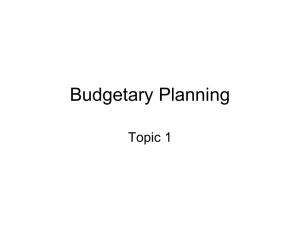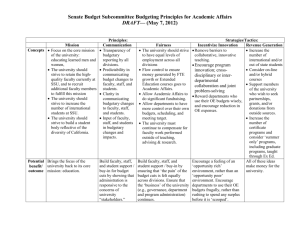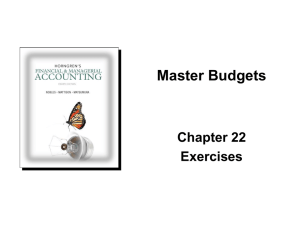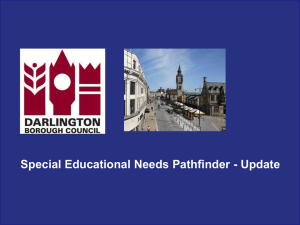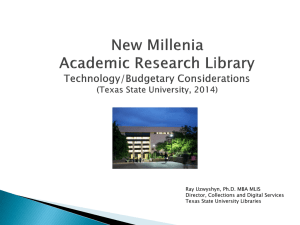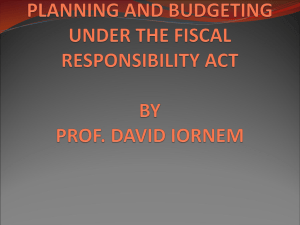Learning from Budget Initiatives
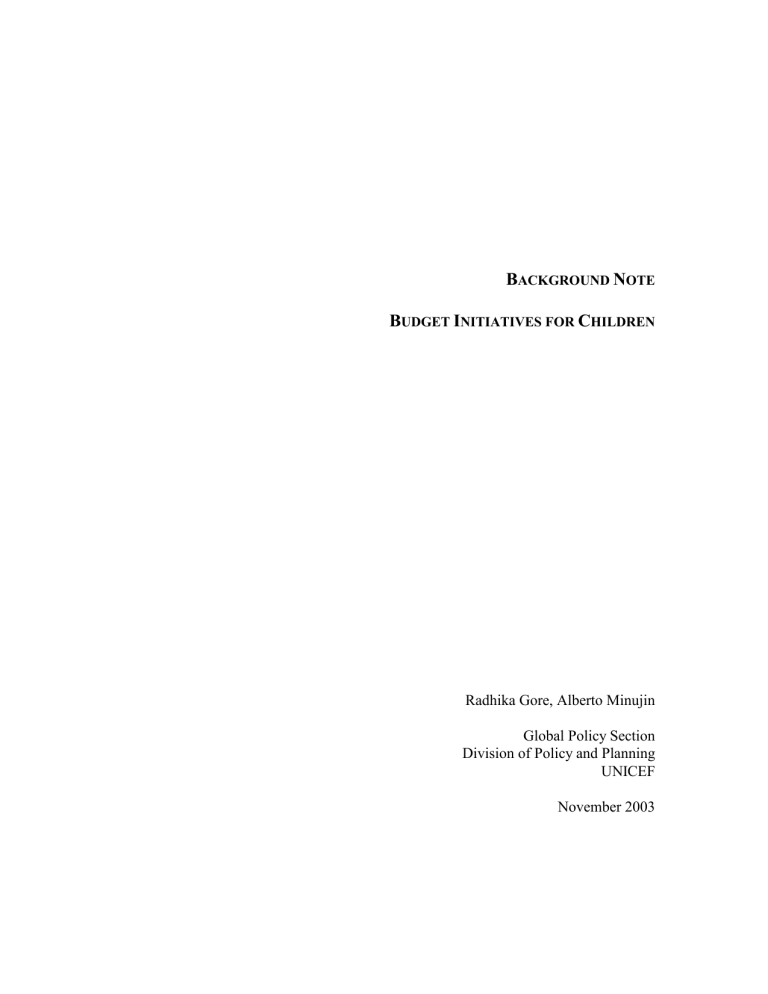
B ACKGROUND N OTE
B UDGET I NITIATIVES FOR C HILDREN
Radhika Gore, Alberto Minujin
Global Policy Section
Division of Policy and Planning
UNICEF
November 2003
T ABLE OF C ONTENTS
R ATIONALE : W HY C ONFRONT G OVERNMENT B UDGETS ?
....................................................... 2
W HY B UDGET I NITIATIVES FOR C HILDREN ?
............................................................................ 3
M ONITORING R IGHTS : L EGISLATIVE R EFORM AND B UDGETARY R ESOURCES ...................... 5
1
BACKGROUND NOTE
BUDGET INITIATIVES FOR CHILDREN
1 Introduction
1.1
Rationale: Why Confront Government Budgets?
Because realizing rights requires funds
For States parties to the Convention on the Rights of the Child (CRC), implementing its provisions has financial implications. Achieving the goals of the World Fit for Children agenda and the Millennium Declaration also calls for state resources. These imperatives directly bring into focus the national budget, which is the financial embodiment of a government’s policy goals. Once approved by the legislature, the budget “authorises the government to raise revenues, incur debts and effect expenditures in order to achieve certain goals. Since the budget determines the origin and application of public financial resources, it plays a central role in the process of government, fulfilling economic, political, social, legal and administrative functions.” 1
The budget is a tool for advocacy, monitoring and participation …
The budget represents a financial commitment to which the government can be held accountable. Social mobilization on national budgetary issues allows state policy to be critiqued, supported or contested. Information from successive budgets and projections can help to track how successfully policy goals are being implemented, and to monitor the realization of children’s rights and development targets. At the community level, the budgeting process provides an opportunity to voice local concerns and priorities for public expenditure, and for society to participate in local government.
…And also an arena for political negotiation and policy-making
Moreover, the budgeting process is a key government activity that involves strategy, planning and negotiation from all public sectors (social, economic, infrastructural, environmental, etc), as well as from various branches and levels of government
(executive and legislature; national and sub-national). In this context, budgets are not only indicators of the quality of governance, i.e. of institutional transparency and accountability, but also a link between macroeconomic policy, social policy, political interests and public resources.
In sum, budgeting is an exercise which serves as a strategic and analytical tool for influencing policy decisions and resource allocation, and monitoring public expenditure.
International institutions support open budgets in the interests of promoting good governance and transparency, which in turn contribute to macroeconomic and fiscal stability since they allow public scrutiny of state finances. Active involvement of the legislature can influence the actions of the executive. Input from other stakeholders brings
1 Elson, D. and Norton, A. What’s behind the budget? Politics, rights and accountability in the budget process.
Overseas Development Institute (ODI). June 2002.
2
alternative perspectives to budgeting decisions and builds social consensus. Budget analysis and participation in budgetary decisions are ways to improve the inclusiveness of public institutions, to empower civil society and to strengthen democratic governance.
Importantly, budget initiatives are a means to ensure that state budgets progressively realize children’s rights.
1.2
Why Budget Initiatives for Children?
Budgets are political
Government budgeting is a political process in which conflicting priorities often compete for limited resources. Budgets are a product of the negotiation of interests and agendas, and are influenced not only by economic objectives and constraints, but also by political interests and international pressures. For example, to realise the rights of children, governments will need to attend to the quality of education; to make available healthcare, food and social security for children; to protect them from abuse; to register each child at birth; and more. All of these actions need financial resources. But spending for other public causes – such as building national infrastructure, investing in industry and subsidizing trade – also requires public funds.
Budgetary decisions can be inequitable…
The priorities that dominate the budget may leave out the rights of weak social groups, of those who have no constituency, power or voice in the budgeting process. The budget may specify an allocation of resources or a channel for raising revenues that is discriminatory, inequitable and ultimately unsustainable.
…And fail to meet children’s needs or realize their rights
Budgets discriminate against children when they do not sufficiently address issues such as child poverty, malnutrition, illiteracy or child protection. Prioritizing children’s rights in public expenditure requires political will and progressive financial commitment from the government. Budget initiatives for children aim to ensure that state budgets reflect the realization of children’s rights.
Children’s rights require advocacy in public finance…
In recent years, gender advocates and economists have made substantial strides in analyzing budgets from a gender perspective. Gender budget initiatives study how public expenditure processes affect women and men, girls and boys differently. They seek to strengthen women’s participation in budgeting decisions, increase women’s economic literacy and encourage gender responsive budget analysis at different levels of government. However, to include the concerns of children in these areas raises the question: Who advocates for children? What aspects of the content or process of the budget need to be considered in analysing budgets for children? How is macroeconomic and fiscal policy to be examined with regard to its impact on children?
3
…But the objective is not to create a separate budget for children
Clearly, budget analysis for children is not aimed at carving out a separate budget for children, but rather at analyzing state budgets for their content, process and impact on children, and devising more equitable procedures and allocations. Moreover, the objective is not only to adjust technical budgeting or management issues, but also to use the analysis to strengthen advocacy for children’s rights, influence the social content of macroeconomic policy, and integrate multiple development goals into policy decisions.
In sum, the rationale for undertaking budget initiatives for children is to: Analyze and influence the budgeting process so that budgets realize children’s rights; influence the social content of economic and fiscal policy; engender social mobilization, consensus, inclusiveness and participation; and monitor public expenditure and governance.
2 Context: Links to other global efforts
2.1
Background: The 20/20 Initiative
The 20/20 Initiative, sponsored by several United Nations organizations and the World
Bank, was adopted at the World Summit for Social Development held in Copenhagen in
1995. The Initiative proposes that in order to achieve universal coverage of basic social services (BSS), 20 per cent of budgetary expenditure in developing countries and 20 per cent of aid flows, on average, should be allocated to them.
The 20/20 Initiative is based on the conviction that the delivery of BSS is one of the most efficient and cost-effective ways of combating poverty. The 20/20 proportion is calculated on the assumption that globally, the volume of resource availability will be such that total government spending in developing countries will remain between 20 and
25 per cent of gross domestic product (GDP) and donor countries will make progress towards the goal of allocating 0.7 per cent of their GDP to overseas development assistance (ODA).
Over the years, the imperative of the 20/20 Initiative has tapered. Moreover, 20/20 focused more on allocations at national level and international development assistance.
Budget initiatives go further: They deepen advocacy and resource mobilization for social services at all levels of government, and involve civil society participation in the process.
2.2
Poverty Reduction Strategies and Budgets
Given that a number of countries that are parties to the CRC are also undertaking poverty reduction strategies,
2
there is a natural avenue in these countries for dialogue on
2 The Poverty Reduction Strategy Paper (PRSP) concept owes its origin to the World Bank and IMF. It was initially introduced in 1999 to promote use of debt relief funds and concessional loans for poverty reduction activities in the world’s poorest and most heavily indebted countries. Typically, a PRSP promotes the development of a government-led national poverty reduction plan in a participatory manner. Each plan has a
4
prioritizing child rights. At the same time, there is a potential conflict between purely economic objectives and child-centred social policies.
Poverty Reduction Strategy Papers (PRSPs) can play a critical role in integrating social and economic policies and representing them in the budget. The core principles underlying the PRSPs include that they are based on broad participation by civil society and the private sector in all operational steps; that they are results-oriented and focused on outcomes that would benefit the poor; and that they are comprehensive in recognizing the multidimensional nature of poverty.
Related to the PRSP is the Medium Term Expenditure Framework (MTEF), which is a linking framework that allows state expenditures to be “driven by policy priorities and disciplined by budget realities.” 3
The MTEF is a central element of Public Expenditure
Management (PEM) reform programs led by the World Bank, since it aims to connect policy making, planning, and budgetary processes. It is not meant to replace the annual budget, but to be integrated into it as a process that refines budget projections.
Conversely, budget initiatives can play an important role in PRSPs. They can give visibility to efforts to integrate gender and children’s concerns in the PRSP, as well as bring transparency to the implementation process. Introducing budget analysis in the
PRSP and in subsequent budget allocations can bring a tangible measure of the relevance of children’s rights and gender in the proposed strategy for poverty reduction.
One example of how PRSPs can be used to strengthen the budgetary process is in
Uganda. The Ministry of Finance Planning and Economic Development (MFPED) of
Uganda has used the principles set out in its Poverty Action Fund (PAF)
4
and the PRSP to encourage government agencies and departments to show how their budget plans achieve
PRSP objectives. Departments that have not come forward with credible plans have been penalised.
5
2.3
Monitoring Rights: Legislative Reform and Budgetary Resources
The imperative for budget initiatives is also indicated in the directives of the CRC reporting guidelines. The process of adopting the CRC in domestic legal systems of
States parties involves not only harmonizing national law and policy with the CRC, but few essential components: Analysis or diagnosis of poverty, setting priorities, development of strategies, monitoring and a description of the participation of stakeholders in these processes. A PRSP is not considered complete without a table (‘matrix’) with information on macroeconomic policies that a country will follow, and the proposed resource allocation and expenditure programme.
3 World Bank. (1998). Public expenditure management handbook
. [Esp. Ch. 3, “Linking
Policy, Planning, and Budgeting in a Medium Term Framework”). The MTEF is the aspect of public expenditure management that focuses on budget formulation, not budget execution or reporting/monitoring.
4 The PAF is mandated with identifying those expenditure programs in the national budget that are particularly relevant for achieving poverty reduction objectives.
5 Mijumbi, P. and Foster, M. How, when and why does poverty get budget priority poverty reduction strategy and public expenditure in Uganda, case study 1.
April 2002. Overseas Development Institute.
5
also identifying the budgetary resources required to realize children’s rights. The legislative reform process thus represents a conclusive channel to analyze the correspondence between law and policy, adequacy of measures taken, and causes of shortfalls in resources, and therefore to directly link the mobilization of resources to the realization of children’s rights.
According to Article 44 of the CRC, States parties are required to submit reports on implementation of the CRC to the Committee on the Rights of the Child 6 . The reports direct States parties to include the measures they have adopted which give effect to the rights recognized in the CRC, progress made in the enjoyment of those rights, and factors or difficulties that have affected the fulfilment of the obligations under the CRC.
As the general reporting guidelines
7
issued by the Committee indicate, the process of preparing a report is an opportunity to facilitate “popular participation and public scrutiny of government policies,” including the analysis of budgetary resources and allocations.
According to the general guidelines for periodic reports 8 , States parties are required to report:
The steps undertaken to ensure coordination between economic and social policies;
The proportion of the budget devoted to social expenditures for children, including health, welfare and education, at the central, regional and local levels, and where appropriate at the federal and provincial levels;
The budget trends over the period covered by the report;
Arrangements for budgetary analysis enabling the amount and proportion spent on children to be clearly identified;
The steps taken to ensure that all competent national, regional and local authorities are guided by the best interests of the child in their budgetary decisions and evaluate the priority given to children in their policy-making;
The measures taken to ensure that disparities between different regions and groups of children are bridged in relation to the provision of social services;
The measures taken to ensure that children, particularly those belonging to the most disadvantaged groups, are protected against the adverse effects of economic policies, including the reduction of budgetary allocations in the social sector.
State parties are also supposed to indicate
9
the proportion of international aid at the multilateral and bilateral levels allocated to programmes for children and the promotion
6 The Committee on the Rights of the Child is the body that monitors how well States are meeting their obligations under the CRC. When a country ratifies the CRC, it assumes a legal obligation to implement the rights recognized in the treaty. Signing up is only the first step, because recognition of rights on paper is not sufficient to guarantee that they will be enjoyed in practice. So the country incurs an additional obligation to submit regular reports to the Committee on how the rights are being implemented. http://www.unhchr.ch/html/menu2/6/crc/
7 General guidelines regarding the form and content of initial reports to be submitted by States Parties under
Article 44, paragraph 1(a), of the CRC: . 30/10/91. CRC/C/5. (Basic Reference Document)
8 General guidelines for periodic reports:.20/11/96. CRC/C/58. Paragraph 20. (Basic Reference Document)
9 Ibid. Paragraph 21.
6
of their rights; the assistance received from regional and international financial institutions; and how such aid and assistance is allocated to the health, education, social and other sectors.
The Committee’s guidelines unambiguously place the reporting of budgetary resources as a responsibility of the State party, and the Committee then subjects the reported information to critical scrutiny. This provides civil society organizations (CSOs), communities and families, as well as legislatures, with the legitimate means to question the State party on the progress made towards realizing children’s rights.
2.4
Role of the Legislature
Under most constitutions, the legislature is required to approve the budget before it is enacted as law and appropriations and taxation measures can be effected.
10 Ideally, approval by the legislature should follow a close scrutiny of the proposed budget, to analyze its fiscal soundness and its matching of needs with resources, and to determine the efficiency of its implementation strategy. So far, legislatures in developing countries have been either politically or technically ill-equipped to carry out this function.
However, in many cases, they are now starting to assume a more active role in budgetary matters.
11
Greater budgetary activism by legislatures is driven by democratization and constitutional change, notably in parts of Latin America, Africa and central Europe. Moreover, since international financial institutions and donor agencies have stressed civil society participation in setting national development goals and strategies (for example, through
PRSPs), national legislatures in developing countries have the opportunity to engage with policy-making and budgets. This opportunity has not been adequately exploited.
Legislatures in many countries are increasingly interacting with CSOs, the media and outside experts. For CSOs, the legislature is a primary channel for advocacy in budgetary decision making. For legislatures, the input of civil society, both through technical training or independent expertise on budgetary issues, can help their engagement with the budget and ensure a balanced view of it.
The International Budget Project cites the example of gender budget initiatives, which in several countries “have emerged as a result of a partnership between parliamentarians interested in gender issues and CSOs able to provide the relevant research and analysis.”
10 From International Budget Project thematic section on Legislatures and Budget Oversight . Accessed Oct
27, 2003. http://www.internationalbudget.org/themes/LEG/index.htm
11 The International Budget Project notes that conversely, in industrialized countries, legislatures have begun to play a less influential role in budget policy making. This is due to the emergence of more disciplined political parties (which have reined in legislative independence), devolution of spending and revenues to lower levels of government (which diminishes the control of public funds by national legislatures), an expansion of entitlement spending (which makes budgets more rigid and decreases the margin for legislative engagement in annual budgets), and the growth of public spending and the increasing complexity of public finances, due to which the executive budget proposal has become the foundation of subsequent legislative action.
7
2.5
Gender Budget Initiatives
Gender budget initiatives are part of broader efforts to “promote women’s economic security and rights and contribute to the eradication of feminized poverty.” 12
As UNIFEM describes, this means improving the power relationships in a woman’s home, in her community and in the marketplace. It means changing policies and legislation to ensure women can exercise their rights and benefit from economic development, and helping women lift themselves and their families out of poverty. Efforts to support women’s economic security and rights include: Engendering macroeconomic frameworks; building capacity of countries to manage globalization and economic transition from the perspective of poor women; promoting enabling institutional, legal and regulatory environments; and bringing a gender analysis to economic policies and the distribution, use and generation of public resources by means of gender responsive budget analysis.
13
Given their rationale in the context of economic security and rights, gender budget initiatives involve strategies and channels for advocacy that can be aligned with children’s budget initiatives. Both seek to create enabling institutions, inclusive processes, and more equitable and socially just resource allocations.
Though implementing the rights of children is entwined with addressing women’s rights, advocacy for children has specific operational implications. For example, gender budget initiatives involve training women’s groups on budget analysis; improving the economic literacy of communities (often women’s groups); mainstreaming gender concerns into macroeconomic policy (often by economists); influencing activities of parliamentarians, municipal office holders and ministers; and capacity-building at government offices.
While children’s participation in the realm of economics and public policy clearly cannot encompass all of the above efforts, budget initiatives for children would draw upon similar analytical and strategic methods.
Governments in some countries incorporate a child rights perspective in their own budgeting progress, notably European governments such as Norway. CSOs in developing countries have begun critically examining their state budgets in relation to meeting children’s needs, and have used the analysis for advocacy, awareness-raising, or as a step towards participatory budgeting. While such initiatives are relatively few, the cases of
Brazil, Ecuador and South Africa are exemplary and are described further below in
Section 4.
3 Influencing Budgets
12 From UNIFEM section on Economic Security and Rights . Accessed Oct 29, 2003. http://www.unifem.org/index.php?f_page_pid=11
13 Ibid.
8
3.1
The Budgeting Process
The budget process as presented below is based on that described by Elson and Norton
(2002).
14
As they indicate, the literature on public expenditure management is mostly normative, and usually presents the ideal types of arrangements (how the system ‘should’ work). While the process that they present draws mostly upon Anglophone systems, the general principles apply in all cases. They also note that, “despite differences in emphasis, audience and objectives [in various source documents], there are substantial elements of consensus which emerge in the discussions of budgets and public expenditure management presented.”
The budget cycle, in almost all cases, is annual. The functional stages (or bureaucratic tasks) associated with the cycle are: budget formulation, enactment/approval, execution and audit/evaluation. In this representation, the policy-making process influences the budget cycle as a factor from outside the budgeting process. The key outputs of the budgeting process are the overall resource envelope, sector limits and sector budget proposals.
The time frame to prepare and execute the budget, and to prepare and audit the final accounts, is typically three years. In order to implement development programmes and policies, the annual budget cycle needs to be linked to a longer term policy, planning and resource allocation process. Budget preparation is the responsibility of a budget department in the Ministry of Finance (MoF) and line agencies. It is executed by accounts or administration departments in line agencies with oversight from the accounts division of the MoF, and is audited by independent auditors. The stages of the process are described further below.
3.2
Entry Points for Budget Initiatives
“Child friendly budgets” do not imply producing separate budgets for children. They aim to identify and influence the impact of budgetary resources and allocations, public institutions, and policy processes, in order to realize the rights of children. They can be undertaken by CSOs or communities, initiated by government officials, or begin with efforts of international development agencies. They are characterised by the:
Origin of their activism (civil society or within government)
Target of their activity (civil society, or national or local government)
Method they use (research, policy or impact analysis, advocacy, capacity-building, community participation, economic literacy, etc.)
This section illustrates the points of entry for budget initiatives along four stages of the budget cycle, with examples.
14 Elson, D. and Norton, A. What’s behind the budget?
ODI. June 2002.
9
Drafting stage
At the national level, at the budget drafting stage, the Ministry of Finance (MoF) first prepares resource projections and forecasts the macroeconomic outlook. The MoF then determines the level of total affordable government expenditure and subtotals according to sector, programme or line ministry. Based on its assessment, the MoF sends out a “budget circular” to line ministries, which includes guidelines for budget plans and invites bids from them.
The line ministries and spending agencies prepare and submit budget requests to the
MoF, according to constraints and goals indicated in the “budget circular”. The MoF and line ministries then negotiate the requests. Expenditure estimates are categorized by line ministry, programme and sector.
Entry points : Budget initiatives at the finance ministry level focus on advocacy to strengthen political will, influencing national policy objectives to ensure more equitable outcomes, analyzing budgets and building technical capacity. Existing channels of civil society participation such as the PRSPs can be used to consult with vulnerable social groups and bring their concerns into the policy-making process.
At the line ministry level, the negotiation process between sectors can get overtaken by competing political agendas instead of being driven by an overall vision. Advocacy efforts can represent the pressing needs of a particular sector (e.g. girls’ education) and also emphasize the inter-relatedness of issues (e.g. education, nutrition and child labour).
Examples
: Australia’s pioneering Government-led initiative in gender budget analysis in the mid-1980s, which was promoted by gender equality activists within the
Government, examined the national budget for its impact on women. In Ecuador,
UNICEF led efforts to work with prominent economists and use technology to analyse voluminous public finance data/accounts. The analysis is used as a capacitybuilding tool to inform government on the impact of social sector spending.
Brazil’s participatory budget exercise is a prominent example at the municipal government level, in which citizens meet in open public assemblies to decide which investments are the most important to them.
Legislative Process: Approval and Enactment
The MoF sends the negotiated budget to the legislature for approval and enactment.
The legislature votes on budget appropriations, and the budget is approved and enacted under the annual budget law.
Entry points : The important target group at this stage is the Parliament, which plays a critical role in analyzing, challenging and approving the budget. Budget initiatives
10
aim to increase awareness and capacity of the legislature to take informed decisions and to monitor the performance of the executive. Clear, accessible, well-presented analysis of public finance data allows for greater transparency and highlights critical information.
Examples : In the budget process in Brazil, Sweden and Switzerland, the legislature votes on and approves the pre-budget statement, which is tabled months before the forthcoming budget. In Australia, the state-level Tasmanian Women’s Budget provides a mechanism for spending agencies to examine whether their programmes are taking into account and responding to women’s needs.
Implementation
Implementing the budget involves the release of appropriations to spending ministries. Line ministries and spending agencies enter into contracts and orders, goods and services are delivered and verified, payments are made and transactions are recorded.
Entry points : The goal is to improve budget execution by monitoring allocations made versus actual expenditure incurred. This can bring to attention unplanned and unsustainable expenditures that deviate from policy goals. Advocacy for freedom of information and using past data to push for greater efficiency in financial flows and more streamlined procedures helps to improve transparency and accountability.
Examples
: The Government of Uganda’s Poverty Action Fund involves civil society groups who monitor the impact of expenditures of select projects. The monitoring activity is paid out of provisions in the budget. At the local government level, the
Mazdoor Kisan Shakti Sangathan (MKSS), a grassroots rural labour movement in
Rajasthan, India, campaigns for the right to information, transparency in local state finances and fighting corruption.
Audit and Evaluation
At year end, the MoF prepares the national accounts, which are audited by independent auditors. The legislature approves the audited accounts. Ideally, the accounts and records are analysed, evaluated and used to inform the following year’s budget process.
Entry points : Initiatives at the budget evaluation stage aim to specify standards for increased government transparency. Activities include disseminating information (e.g. publicizing sectoral budgets); increasing access to and capacity of civil society to public accounts; promoting economic literacy; assessing the clarity of roles, responsibilities and functions of different levels of government and publishing citizen’s guides to management of macroeconomic processes.
11
Examples : In South Africa, the Institute for Democratic Alternatives (IDASA) assesses the transparency and accountability of national budget arrangements.
IDASA’s Budget Information Service works directly with community-based organizations to improve economic literacy. In Bolivia, the Women’s Coordinating
Organization, a network of women’s non-government organizations (NGOs), trains
40 municipalities on economic and social rights and on how to take an informed look at municipal budgets and propose alternatives.
3.3
Civil Society in the Budget Process 15
Applications of budget analysis are relatively recent endeavours for CSOs, and it is difficult to generalize results. However, the following examples and their impacts show the potential of these initiatives.
Drafting: This stage is generally dominated by the executive. CSOs lack formal channels for intervention and might use the media to voice concerns. Efforts to influence the priorities underlying budget policy choices include those in Kenya, for example, where the Institute for Economic Affairs coordinates an annual civil society meeting with broad stakeholder attendance, which results in a set of agreed priorities that are reported to the
Government. The Kenyan Government has since formally requested this analysis as annual input into the drafting stage.
Approval and Enactment: At this stage, legislature debates and can change the budget, and CSOs have opportunities for direct intervention. Legislatures are often poorly informed and unable to technically analyze the budget; therefore, CSOs can augment the technical capacity of the legislature. For example, the Institute for Public Finance in
Croatia published a budget guide that was discussed in the media and in parliament. In
Mexico, the Centre on Research and Teachings in Economics (CIDE) provides budget training to the legislature, the media and civil society. In Zambia, CSOs facilitate commentaries on the budget in parliament and organize National Budget Workshops with the Minister of Finance and Economic Development.
Implementation: CSOs can collect information on budgetary expenditure, revenue and outputs that will contribute to the quality of their participation. Some civil society groups have addressed specific implementation issues. For example, the Centre for Budget and
Policy Studies in Bangalore, India, has produced an analysis of the difference between planned and actual expenditures. The Structural Adjustment Participatory Project in
Ghana and the Catholic Commission for Justice and Peace in Zambia have used their structural adjustment monitoring work to focus on budget plans and disbursements.
Auditing: Few civil society groups do work at the auditing stage, for several reasons: the audited report is presented two years after the close of the financial year; and there is little incentive to scrutinize public accounts in the parliamentary system because of weaker
15 Krafchik, Warren. (2002). ‘Can civil society add value to budget decision-making?’ In Karen Judd (Ed.),
Gender Budget Initiatives: Strategies, Concepts and Experiences . UNIFEM. Pp70-85
12
legislative budget power. One example, however, from Kerala, India, shows that there are participatory audit techniques at the community level.
3.4
Examples of Approaches and Tools
This section provides examples of broad approaches that budget initiatives use, and the specific tools that they employ.
Broad approaches
16
Comprehensive budget analysis with recommendations: Combine information from different sectors, such as education, health, welfare, agriculture, monetary policy, taxation, etc., and present comments and recommendations on the budget.
Evaluate macroeconomic variables/assumptions: Examine the macroeconomic assumptions underlying the budget and project the effect of the budget on variables such as the deficit, national debt, interest rates, employment, etc. Bring into question the government’s forecasts and the potential impact on the social sectors.
Measure transparency and participation: Identify and detail the distribution of actual inputs, activities and outputs of the budget to make the budget accessible or demystify it. Use some form of stakeholder survey to review the degree of transparency and participation in the budget process.
Measure effectiveness: Evaluate how the budget funds social services for children and how it achieves the realization of children’s rights. This helps to measure the effectiveness (with respect to costs, time, etc.) of the strategies employed to achieve policy goals.
Analysis by sector or group: Analyse the impact on specific sectors or socioeconomic groups. Compare allocations of these sectors with other sectors, the entire economy or past levels of support. Incidence group analysis falls into this category.
Analysis by taxation and revenue: Examine the distributional impact of proposed taxes or the sustainability or sufficiency of revenue proposals to fund proposed expenditures.
Feedback into future planning: Use insights from budget analysis and incorporate the specific concerns of economic and social rights into the planning process. This helps to transform the budget to be more inclusive and provides opportunities for civil society participation.
16 Ibid.
13
Specific tools
17
Expenditure tools
Policy appraisal: Analyse economic and social policies and programmes to see how far the policies and their associated resource allocations are likely to reduce or increase benefits for specific groups or individuals.
Public expenditure incidence analysis: This is a method to measure the benefits of publicly provided goods to individuals in society. It is difficult to use prices as the basis for valuing public goods, many of which are subsidized or freely provided and benefit communities as a whole. Even so, their supply is rationed, so that a rationed public good can be evaluated at the individual’s own valuation of it.
Benefit incidence analysis examines the cost of providing public services and how these are used in order to see how equitably public spending is distributed.
18
Beneficiary assessments: Assess public perception of how far public spending is meeting their needs. Use opinion polls, attitude surveys, group discussions, organized debates with citizens and a discussion of proposals for the coming year, etc. Through these exercises, development concerns such as social inclusion and poverty reduction can be integrated into public expenditure management (PEM), along with budgetary requirements of fiscal prudence, economic growth and political realism.
Revenue tools
Budget initiatives have so far mostly focused on expenditure allocations. However, revenue tools are required for a better understanding of how gender and family or household structure affects the impact of revenue-raising measures, as well as to complement work done so far on the expenditure side. Such efforts would examine the following:
Direct/personal income tax: Gender-bias can occur when non-labour income or tax expenditure is allocated to the male spouse only, or is not available to a married woman who is the head of the household as its main earner.
Indirect/commodity tax: Following economic liberalization policies, there is a trend to reduce direct taxation and increase indirect taxation. The effect of this might seem neutral across society since the latter is a tax on commodities.
However, men and women consume different products and services, and this could have significant gender implications.
User fees: Many governments now consider user fees as alternatives to tax-based financing. However, studies have not confirmed that these are effective, efficient
17 Hewitt, Guy. (2002). ‘Gender responsive budget initiatives: Tools and methodologies.’ In Karen Judd
(Ed.), Gender Budget Initiatives: Strategies, Concepts and Experiences . UNIFEM. Pp30-37.
18 Demery, Lionel. (2002). ‘Gender and public spending: Insights from benefit incidence.’ In Karen Judd
(Ed.), Gender Budget Initiatives: Strategies, Concepts and Experiences . UNIFEM. Pp38-55. In the context of programme monitoring and evaluation, the term “incidence” refers to the distribution of immediate outputs from a particular programme across groups within the population where the programme is active.
For example, gender-disaggregated incidence analysis estimates the distribution of budget resources (or changes in resources) among males and females by measuring the unit costs of providing a service and multiplying that cost by the number of units used by each group.
14
or equitable. They can have particularly negative effects on the poor, such as reduced utilization of public services and decreased well-being and health.
Impact of globalization: Other issues such as corporate taxes, customs duties, debt servicing, etc. can all have negative distributional/equity effects.
4 Learning from Experiences
4.1
Country Case Studies
This section briefly notes examples of budget initiatives in Brazil and Ecuador, in which
UNICEF has been involved. It also presents examples of initiatives in South Africa and
Tamil Nadu, where UNICEF has not been involved. The efforts in South Africa have been pioneering and are particularly noteworthy.
Brazil
The UNICEF country office has supported the following efforts:
The Child Budget : This is a national-level effort that aims to promote transparency in the use of public resources through monitoring public budgets and providing relevant information to civil society groups and others. Along with other organizations, in 1995 UNICEF helped formulate the Pact for Children document, which highlighted the importance of monitoring public policy financing that affects children. It supported a study that showed how government action and resources could achieve children’s rights, and worked with a local NGO to implement the recommendations of the study. It also supported local NGOs to improve their distribution materials.
The Municipal Kit : The Kit, a series of five booklets, was developed by a local foundation to familiarize citizens, especially teachers and students, with the municipal budgetary process, and to assist them to play an active role. UNICEF supported the foundation to produce the Kit. It also supported government efforts to promote discussions on proactive popular participation in the political realm amongst NGOs, government agencies, communities and children, and coordinated efforts with a local NGO to enable community members to attend and speak in public hearings.
Participatory Budget : This is a government-led methodology emerging in certain parts of Brazil for increasing popular participation in financial decision-making. It aims to involve ordinary citizens in defining local-level spending priorities.
UNICEF’s role has been limited to supporting the local administration in certain towns to implement the initiative.
15
Ecuador
Beginning in 1999, as Ecuador was facing an economic crisis, UNICEF Ecuador decided that to protect children’s rights, it was necessary that the government and society understand its roots in order to develop and implement meaningful solutions.
The goal was to minimize the negative impact of recent economic shocks on the poor, especially children, by shaping public policies based on a consensus regarding a society’s obligation to its members. The UNICEF Ecuador country office worked in several areas:
Budget analysis
UNICEF brought together an experienced and respected team of international and local consultants to analyze the economic situation and its implications for children, with a focus on the national budget. The study concluded that social sector allocations do not help the poor, because expenditures are uneven and inefficient.
The results were presented to key figures in Ecuador, including the president, cabinet members, and political party leaders. The idea of linking social and economic decision-making was accepted, and social spending increased by 15.5% over the amount originally allocated during 2000, helped in part by a spike in oil income.
-
UNICEF was given access to the government’s database, used a software programme to analyse the impact of budgetary decisions on children’s well-being, and produces a periodical Bulletin which is distributed to legislators, NGOs and the media.
World Bank negotiations : UNICEF helped the government negotiate with the World
Bank to develop an emergency assistance programme financed by government funds rather than loans. Its rights-based approach was incorporated into the government
Emergency Social Plan. Ecuador’s 2001 social spending increased to $83 per person, up from $55 in 2000.
Tax reform : For the 2001 and 2002 budgets, UNICEF produced simple, clear publications to illustrate inequities in the national tax structure and spending during fiscal crises. It used media coverage to focus the debate over tax reform on social justice, rather than simply on balancing the budget. By 2002, taxes grew to 13.7% of national revenues, compared to 6.4% in 1999.
Foreign debt : UNICEF worked with the Ministry of Social Welfare and an international debt-relief NGO to develop a plan (partly adopted by the Paris Club) to allow the country to swap debt payments for social investment.
Monitoring social spending : UNICEF (i) supported the national Databank of Social
Indicators to develop indicators on the situation of children and adolescents, (ii) created a “Citizens’ Observatory,” comprised of an influential group of citizens to
16
monitor the status of children and advise the government, (iii) encouraged a form of child rights monitoring at the municipal level in which mayors advocate for their communities with higher levels of government and (iv) established citizen-based surveillance groups in indigenous communities.
South Africa
Though UNICEF has not been involved in the child budget initiatives in South Africa, the experience here is seminal and noteworthy. Efforts have been led by the Institute for Democracy in South Africa (IDASA), a national NGO whose mission is to promote sustainable democracy by building democratic institutions, educating citizens and advocating social justice. One of IDASA’s programmes is the Budget Information
Service (BIS), which tackles South Africa's budget system through research, analysis, training and capacity-building, with the goal of alleviating poverty. The Children’s
Budget Project of the BIS helps the government and civil society meet children's needs within budgetary constraints. It examines the relationship between children's rights, government expenditure and poverty alleviation. Since 1995, it has produced publications such as:
A pilot study of the Sexual Offences Court. (2001). South Africa's constitution strives to protect children. Yet, in 2000, 25,578 cases of sexual abuse against children were reported to the police. This study of the Sexual Offences Court considers whether the conviction of sexual offences has increased, whether secondary trauma to child victims has decreased, whether there is sufficient collaboration between sectors and whether sufficient resources have been allocated.
Funding the development of young children . (2001). The South African government has prioritised early childhood development in many of its policies and programmes. This review of public policy and funding examines three departments responsible for service delivery to young children: education, social development and health.
Keeping children out of jail: is enough being done?
(2001). The constitution guarantees children the right not to be detained in prison, except as a last resort.
This budget brief identifies the factors that seem to prevent the government from providing adequate facilities for children awaiting trial or those sentenced to secure care.
Child Poverty and the Budget 2000: Are Poor Children Being Put First?
(2000).
In its National Programme of Action for Children, which demands that children be 'put first' in policy, budget allocations and service delivery, the South African government promises to alleviate child poverty. This book questions the claim.
17
Budget 2001 does little for child poverty . (2001). Budget 2001 seemed to offer poor children a lot: an increase in the child support grant, changes to childspecific poverty reduction programs and assertive measures for growth and employment creation. This Budget Brief argues that more could have been done to
"put children first."
Tamil Nadu, India
The UNICEF office in the State of Tamil Nadu has not directly been involved in local budget initiatives, which are mostly concerned with analysis of past budgets. Efforts of public and private sector entities indicate that a level of awareness and capacity already exists at national and local level; however, the quality of analysis remains to be examined. Examples of efforts are:
Budget Analysis as Social Audit: Tamil Nadu Experiences . (2002). This is a report by the Tamil Nadu Peoples’ Forum for Social Development, a local NGO which is part of a national initiative/network called People’s BIAS [Budgetary
Information and Analysis Services]. The report critiques social development in
Tamil Nadu and sums up the Forum’s experience with budget analysis as related to social development, monitoring and social policy advocacy.
-
India’s Children and the Union Budget
. (2001). This is a decadal (1990-2000) analysis of the national budget from a child rights perspective conducted by the
HAQ Centre for Child Rights, a national NGO that focuses its advocacy on the rights to survival, childhood and equal opportunity. For the first time, the
Department of Women and Child Development of the government of India included a chapter on the child budget in its annual report 2002-2003, drawing upon this study.
Children on the State Agenda . (2001). This an analysis of the Tamil Nadu State budgets for 1998-2003, conducted by the Indian Council for Child Welfare, an established national NGO. The report analyzes the budget in the context of education, health, nutrition, early childhood care and development, children in difficult circumstances, and the girl child. It examines relative and absolute budget allocations, intra-sectoral resource allocations, services provided, beneficiaries reached, effectiveness of monitoring and training, sources of funds, etc.
4.2
Lessons Learned
Characteristics of initiatives
The objectives, methodology and quality of success of different initiatives depend not only on the country context, but also on the technical capacity, resources and relevance of the initiating group. The following table categorises the activities of the initiatives described above:
18
Budget initiative National or local?
Brazil – Child Budget
Brazil – Municipal Kit
National
Local
Brazil – Participatory Budget Local
Ecuador – Child Budget National
Led by civil society or govt?
NGO
NGO
Govt
UNICEF
Ecuador – Economic policy National
South Africa National
Tamil Nadu
UNICEF
NGO
National, local NGO
Public partnership or privately led?
Private
Partnership
Partnership
Private
Partnership
Private
Partnership
Nature of effort*
1, 2, 3
1, 2
1, 5
1, 2, 3, 6
6, 8
1, 2, 3
1, 2, 3
* Nature of effort includes the following:
1.
Technical analysis of past and/or future intended budgets
2.
Awareness raising, dissemination of technical information to demystify budgets
3.
Advocacy to influence social and economic policy-making and budget allocations
(linked to budget negotiations) at ministerial/sector level
4.
Advocacy to inform and support parliamentarians
5.
Participation in budget drafting, at local/community level through community mobilization and locally-elected budget representatives
6.
Participation in budget drafting at national level through consultations with non-state actors, CSOs, experts, academics, etc
7.
Monitoring by participating in budget execution/expenditure or through publishing of public accounts and expenditure processes (transparency)
8.
Informing government actors and supporting government negotiations with international institutions on socio-economic policy
Factors of success
The lessons learned from the country case studies reinforce what is indicated in reviews and findings from other such initiatives. Among their factors of success are the following:
Budget analysis skills are key . Technical expertise in budget analysis is essential to advocate for, negotiate, participate in and support informed decision-making on public expenditure issues. This implies developing analytical tools that are tailored to the country context. Without concurrently strengthening the technical capacity of state actors, budget analysis remains an academic exercise.
Empowerment begins with quality of information.
Across countries, a common finding regarding budgets is that they are complex, unclear and difficult to access. Technical analysis needs to clearly presented and strategically distributed to a wide and interested audience (for example, educators, media, parliamentarians, etc).
Transparency and participation are interdependent . Effective participation requires not only access to information and the capacity to analyze it, but also opportunities to challenge and act upon it, i.e. to hold government accountable and to influence policy.
19
Realizing children’s rights requires rethinking institutional processes and policy-making.
Budgets need to be situated in the broader context of how policies are made and implemented. The question of integrating social policy in macroeconomic policy, instead of regarding it as an add-on to macroeconomic goals, is an area of study which has the potential to change the basis of policy decisions so that outcomes are more equitable.
Socio-economic and political issues in fiscal policy, decentralization, legislative and institutional reform, etc, are all pertinent to the realization of children’s rights.
Effective advocacy requires understanding the politics of budgeting.
This implies dealing not only with the mechanics of budgeting, but understanding the interests of, and developing strategic alliances with, state actors, media, academia, CSOs, international partners, etc.
5 Conclusion: Strategies for UNICEF
As discussed above, the budget cycle presents various opportunities for action. Strategies for UNICEF could include the following:
Link children’s rights and public policy with the Millennium Development goals and the World Fit for Children agenda: Given that national budgets encompass policy goals, strategies and resource availability, they form a key area to resolve the integration of social policy in multiple development goals.
Link budgets with legislative reform in the context of implementing the CRC.
Link budgets with PRSPs and Medium Term Expenditure Framework: The PRSP process presents a ready and natural channel for making national budgets more participatory, transparent, and sensitive to children’s rights and social policy.
Integrate with gender responsive budget initiatives: Collaborating with UNIFEM, gender advocacy groups, economists and other interested actors would align efforts, particularly at UNICEF country offices, and enable sharing of resources, research, information and channels for advocacy.
Build technical capacity at all levels: Strengthening UNICEF’s capacity to dialogue with governments and legislatures on socio-economic and public finance issues would enrich its policy analysis and improve its advocacy efforts.
Collaborate with academia and research institutions: This is important for identifying trends and new directions in economic, fiscal and institutional reform in the context of children’s rights, and for undertaking multi-disciplinary social science research.
Data for budget analysis: Credible and useful analysis will require disaggregated budget data from a child rights and gender perspective.
20
References
Budlender, D. (1999). The South African Women’s Budget Initiative. Paper prepared for workshop on Pro-Poor, Gender- and Environment-Sensitive Budgets, New York, 28-30
June 1999.
Cassiem, S., Perry, H., Sadan, M., Streak, J. (2000). Child poverty and the budget in
South Africa . Budget Information Service, Institute for Democracy in South Africa.
Elson, D. and Cagatay, N. (2000). The social content of macroeconomic policies . World
Development, Vol. 28, No. 7, pp. 1347.
Elson, D. and Norton, A. (June 2002).
What’s behind the budget? Politics, rights and accountability in the budget process.
Overseas Development Institute.
Foster, M. and Fozzard, A. (Oct 2000). Aid and public expenditure: A guide . Overseas
Development Institute, Centre for Aid and Public Expenditure, Working Paper 141.
General guidelines regarding the form and content of initial reports to be submitted by
States Parties under Article 44, paragraph 1(a), of the CRC: . 30/10/91. CRC/C/5.
General guidelines for periodic reports:.20/11/96. CRC/C/58.
International Budget Project. Thematic section on Legislatures and Budget Oversight .
Accessed Oct 27, 2003. http://www.internationalbudget.org/themes/LEG/index.htm
International Monetary Fund. Guidelines for public expenditure management . Accessed
July 2003. http://www.imf.org/external/pubs/ft/expend/guide3.htm
Karen Judd (Ed.) (2002). Gender budget initiatives: Strategies, concepts and experiences .
Papers from a high level international conference ‘Strengthening Economic and Financial
Governance Through Gender Responsive Budgeting.’ Brussels, 16-18 October, 2001.
UNIFEM.
Mijumbi, P. and Foster, M. (April 2002). How, when and why does poverty get budget priority: poverty reduction strategy and public expenditure in Uganda, case study 1.
Overseas Development Institute.
Office of the High Commissioner on Human Rights. Section on the Committee on the
Rights of the Child. Accessed Oct 29, 2003. http://www.unhchr.ch/html/menu2/6/crc/
UNDP, UNESCO, UNFPA, WHO, and the World Bank joint publication. (Sept 1998).
Implementing the 20/20 Initiative.: Achieving universal access to basic social services .
21
UNDP. Grinspun, A. (Ed.) (2001) Choices for the poor: Lessons from national poverty strategies .
UNIFEM. Thematic section on Economic Security and Rights . Accessed Oct 29, 2003. http://www.unifem.org/index.php?f_page_pid=11 de Vylder, Stefan. (1996). Development strategies, macroeconomic policies and the rights of the child . Discussion paper for Radda Barnen (Swedish Save the Children).
Wagle, S. and Shah, P. (Jan 2002). Participation in public expenditure systems. An issue paper . World Bank, Participation and Civic Engagement Group, Social Development
Department .
Wildavsky, A. (1984). The politics of the budgetary process.
World Bank. (1998). Public expenditure management handbook . [Esp. Ch. 3, “Linking
Policy, Planning, and Budgeting in a Medium Term Framework”)
22

